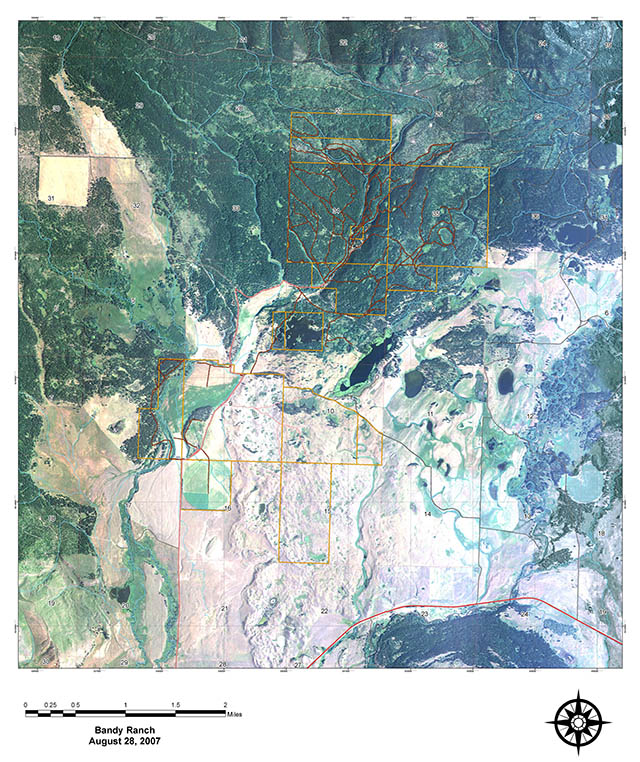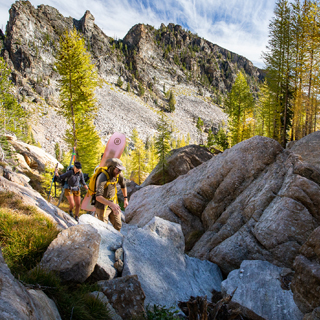Bandy Ranch
 Bandy Ranch is 3,596-acre working cattle ranch deeded to the Montana Forest and Conservation Experiment Station at the University of Montana in 1990 by the estate of Ed Bandy for agricultural, rangeland and timberland research and management. The ranch is in Powell County northwest of Ovando, and adjacent to Upsata Lake and the Blackfoot-Clearwater Wildlife Management Area.
Bandy Ranch is 3,596-acre working cattle ranch deeded to the Montana Forest and Conservation Experiment Station at the University of Montana in 1990 by the estate of Ed Bandy for agricultural, rangeland and timberland research and management. The ranch is in Powell County northwest of Ovando, and adjacent to Upsata Lake and the Blackfoot-Clearwater Wildlife Management Area.
In 1896, Charles A. Jakways purchased 1,620 acres from the Northern Pacific Railroad Company that later became part of the Bandy Ranch. Edward Bandy and his wife bought the property in November 1916 and raised their seven children there. When Edward Sr. died in 1944, the ranch passed to his son Edward Jr. who purchased more land to increase the size of the ranch. He ran a Herford cow-calf operation. He was also a recognized conservationist and part of the North Powell Conservation District; in 1963 he was selected as outstanding conservationist in the district. Mr. Bandy was an innovator who was often the first in the valley to adopt conservation-ranching practices like above-ground irrigation, solar heat collection and radiant heat in the ranch shop, and windbreaks to create wildlife habitat, among others. Mr. Bandy was dedicated to education and contributed to the University of Montana throughout his life; he very generously left the ranch to the Montana Forest and Conservation Experiment Station in his will when he died on Oct. 30, 1989.
Ranch Resources
Bandy Ranch is mantled with Pleistocene materials (glacial till) and contains some outcrops of Miocene and Oligocene lake deposits. Bandy was shaped by three glacial advances, the last of which left a disintegration moraine, sometimes called kettle and knob, in the prairie/pothole tract in the southern part of the ranch. Bandy is a forest-prairie ecotone that contains glaciated depressional wetlands and native bunchgrass prairie as well as forested sections. Tree species include Western larch, Ponderosa and lodgepole pine, and Douglas-fir. Shanley and Cottonwood Creeks flow through the ranch on their way to join the Blackfoot River; both contain cutthroat trout. Bandy Ranch and surrounding habitat is nesting area and summer habitat for greater sandhill cranes and is used by long-billed curlews, black terns, vesper sparrows, and 13 waterfowl species. The land is also important fall-winter-spring range for the Blackfoot-Clearwater elk population and important habitat for black bears, grizzly bears, and wolves. Trumpeter swans that were reintroduced into the Blackfoot Valley use Bandy's reservoir. Bandy Ranch is protected by conservation easements with the U.S. Fish and Wildlife Service, The Nature Conservancy, and Montana Fish, Wildlife and Parks.
Current Activities
Several management projects have benefited Bandy Ranch in the past several years. In 2015, the college partnered with the Big Blackfoot Chapter of Trout Unlimited, Wym and Jan Portman, U.S. Fish and Wildlife Service’s Partners for Fish and Wildlife, Montana Fish Wildlife and Parks, and the Westslope Chapter of Trout Unlimited to install a new bridge across Shanley Creek on the Portman’s property, remove two too-small culverts, and build a new road out of the riparian area. Forestry students completed the work by planting grass along the new road and processing the logs cut from the road right-of-way. Students have also participated in planning a forest restoration operation at Bandy. Professor John Maron at UM also has long-term research plots at Bandy as part of a study on resident vegetation and rodents' influence on plant community assembly.

